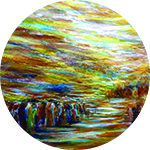Making It Big


M ore often than not we prefer “big” over “small.” We’d like a big house a big salary a big car. We’re attracted to big signs and big headlines. Most people want to “make it big” in business and have a “big name” among their colleagues.
As we know everything in the physical world has a parallel in the spiritual world.
We tend to consider the physical world the “real” world. When we talk about Yad Hashem for instance we think that the real hand is our hand and Hashem’s Hand is the metaphor. In fact the opposite is true.
As Rabbi Akiva Tatz so eloquently explains the real “hand” is Hashem’s; our hand is a metaphor for Hashem’s spiritual Hand. So it is with every physical attribute. The reality is the spiritual reality; the physical exists to help us grasp the spiritual concept that it represents.
The concept of “big” in the physical world is a metaphor for that which is big in the spiritual world. Our desire for that which is big in the physical world is the physical manifestation of the neshamah’s craving for that which is big in the spiritual world. Our longing to “make it big” in worldly matters is in actuality a metaphor for our neshamah’s yearning to be great in ruchniyus matters.
What does it mean to be great? How can we become “big” in a real way?
Real Greatness
Rav Tzadok explains that the inner essence of a concept can be understood by examining the first time it’s mentioned in the Torah. The first mention of the root of gadol big is in reference to the creation of the sun and the moon which are called the “meoros hagedolim.”
It would follow then that the concept of gadol is related to possessing light and radiating light to others. When a person works on himself to become a person of light and to radiate his light to others he is on the path to gadlus. At a bris when we say “Zeh hakatan gadol yihiyeh ” we are not just blessing the infant that he grow into an adult; we are also giving a brachah that he become a luminary.
When Moshe Rabbeinu came of age the Torah describes him with the words “Vayigdal Moshe — Moshe became big.” How did Moshe’s greatness manifest itself? The pasuk continues “Vayeitzei el echav — He went out to his brothers.” He actively sought out ways to assist his brethren and ease their burden.
It is no wonder that our great Torah leaders are referred to as gedolim. Like the sun they’re people who radiate light and warmth and illuminate the lives of others.
Expanding the Circle
The primary goal of a person in This World is to develop his middos by emulating the middos of Hashem. Moshe Rabbeinu used the word gadol to praise HaKadosh Baruch Hu (see Devarim 10:17). The Anshei Knesses Hagedolah incorporated this praise in the first brachah of Shemoneh Esreh. What middah of Hashem is represented by the description “gadol”?
Rabbi Yitzchok Kirzner quotes the Zohar which defines gadol as meaning that Hashem does acts of loving kindness (The Art of Jewish Prayer pp. 48). When we perform acts of chesed toward others we’re fulfilling our life’s mission of emulating Hashem.
Rav Shimon Shkop describes the process of a person’s growth in the following way: When a person begins his life as an infant he’s concerned only with his own comfort and pleasure. His circle of “ani ” his “I ” includes only one individual — himself. As he grows and develops his circle of ani expands to include his immediate family then his friends then perhaps the members of his school or his shul and perhaps his entire community. A gadol is an individual who includes all of Klal Yisrael in his circle of ani.
Rav Shkop’s explanation helps us understand the lofty level of a gadol and — perhaps even more importantly — how each of us can achieve gadlus. It’s not that the definition of a “big” person is that his circle of ani is bigger; rather the way one becomes “big” is by making one’s circle of ani bigger. Expanding one’s ani is not merely a description of greatness; it’s a prescription for greatness.
We all have an innate yearning for greatness. How can we become great? By consciously working to include others in our circle of ani and increasing our acts of chesed.
As women who are involved in acts of chesed practically every moment of our lives we may feel that we are so busy taking care of others we have no time left to develop our own ruchniyus. In actuality taking care of others is developing our ruchniyus. As we do for others we are emulating Hashem. As we expand our circle of ani we are expanding ourselves. Certainly we need to do things that leave us feeling inspired. However all the seemingly mundane acts of chesed that fill our days are the very acts that bring us true greatness.
Expanding one’s circle is a prerequisite for a man’s greatness in Torah as well. The Chazon Ish expressed to Rav Chaim Brim that Torah is not a chochmah related to the mind; rather it’s a ruchniyus phenomenon related to the neshamah. He explained that the more chesed a person does the greater his neshamah becomes and the greater the capacity he has for learning and understanding Torah.
Rav Don Segal in his hesped for Rav Yisroel Belsky ztz”l quoted the above statement by the Chazon Ish and concluded “It’s no wonder that the Rosh Yeshivah was so great in Torah since he was a true gadol in chesed” (quoted in a Yated Ne’eman article by Rabbi S. Fischer). Expanding one’s circle enables a person to be a larger receptacle with the capacity to hold more Torah.<
Forming a Unit
The root word gadol — gimmel daled lamed — has the mispar katan of ten. The number ten consists of two digits representing a ten and no ones. According to the Maharal the number ten represents the idea of many individual entities becoming one unit. The ten maamaros with which Hashem created the world were ten individual utterances that fused together to create one world. Similarly ten men who comprise a minyan are ten individuals who merge together to form a single unit.
Perhaps the significance of the mispar katan of gadol being ten is to teach us that the key to achieving gadlus is to view ourselves and others not as separate distinct entities but rather as parts of one whole of Klal Yisrael. Rabbi Paysach Krohn notes that the word achzar cruel is comprised of the words ach and zar which mean “only a stranger.” If we can work on ourselves to see through the exterior of other people whom we may find annoying or bothersome if we can relate to the common neshamah that connects us we’ll expand ourselves and become bigger people.
We’re now in the period of Sefiras Ha’omer counting the days to Matan Torah. I’ve often wondered: Why did our Sages mar the simchah of the days leading up to Matan Torah by instituting a period of mourning for the death of Rabbi Akiva’s talmidim during this time?
It must be that Chazal determined that the most effective way for us to prepare for Matan Torah is by learning the lesson inherent in the death of Rabbi Akiva’s talmidim.
Rabbi Akiva’s talmidim were phenomenal talmidei chachamim. However on their level they were found lacking in the respect that they accorded each other and they could not be the ones charged with the mission of passing down the mesorah.
When we mourn for the talmidim of Rabbi Akiva we are supposed to come to a deeper understanding of the value of every person in Klal Yisrael. By internalizing the importance of expanding our ani by working on ourselves to emulate Hashem’s middah of “gadol ” we become truly big people ready for our personal matan Torah. (Originally featured in Family First Issue 538)
Rebbetzin Suri Gibber has been involved in chinuch banos for decades first as general studies principal in Bais Yaakov High School of Miami and for the past 15 years as principal of Bais Yaakov High School of the Twin Cities. She gives adult education classes as well.
Oops! We could not locate your form.





